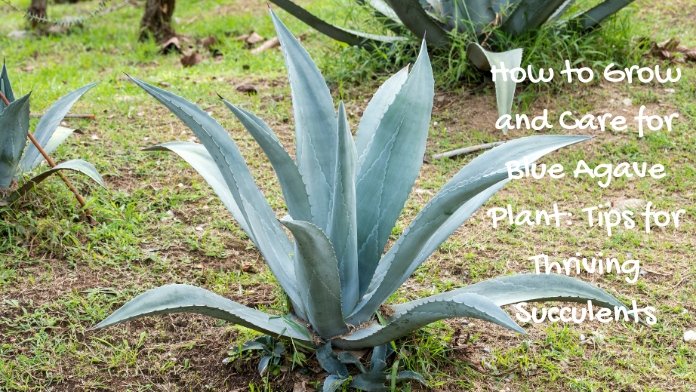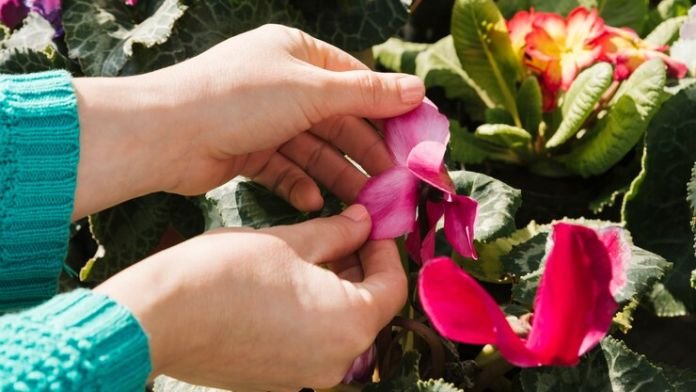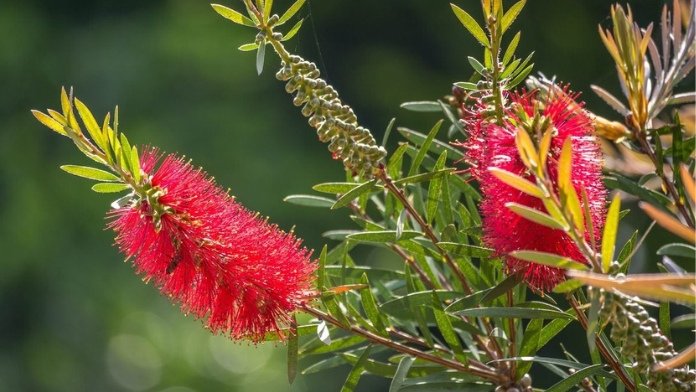
The Dragon’s Breath plant is a charming addition to any plant collection. It is known for its bright red feathers and vibrant red leaves. These plants can be grown from seed, grow 20 to 24 inches tall, and add plenty of drama to the fall landscape.
Sakata Seed’s Celosia ‘Dragon’s Breath Red’ has undoubtedly caught the attention of growers, retailers, and garden enthusiasts nationwide with its deep, hairy maroon leaves and plum blossoms.
Growers love that Dragon’s Breath is quick, easy, and cost-effective (for spring or fall) to produce with minimal need for growth regulators and fertilizers.
This guide will explain everything you need to know about this unique plant, from its origin to its care requirements. Explore the fiery charms of the Dragon’s Breath Plant!
About the Dragon’s Breath plant
Original Residence
The dragon’s breath plant, scientifically known as Celosia argentia plumosa, is from the tropics. It is a staple food in the landscapes of Africa, Asia, and South America and thrives in hot, humid climates. This plant’s exotic origin contributes to its mystery and appeal.
Historical Meaning
Historically, celosia was valued not only for its beauty but also for its utility. It has been used medicinally in various cultures, and its seeds are eaten as a grain.
With its intense colors and feathers, the dragon’s breath variant has become a symbol of vitality and resilience.
Botanical Properties
Physical Description
The dragon’s breath plant is known for its attractive flame-like feathers, which range in color from deep red to bright orange.
These plumes are made of densely packed small flowers, creating a feathery appearance. The plant’s leaves are usually green, which provides a stark contrast to the fiery flowers.
Growth Pattern
Dragon’s breath plants can grow up to 2-3 feet tall, making them stand out in the garden. They have a bushy growth habit, with multiple tufts emerging from a single plant. This vigorous growth makes them ideal for adding volume and color to garden beds and borders.
A variety of dragon’s breath plants.
Popular Varieties
Although Dragon’s Breath is a distinct variety of Celosia argentia, several varieties within the species have different characteristics. Some popular varieties include:
- Celosia ‘Intenz’: Known for bright magenta feathers.
- Celosia ‘Fresh Look’: Features vibrant tufts throughout the growing season.
- Celosia ‘Kimono’: A dwarf variety, perfect for container gardening.
Growing Conditions

Soil Requirements
Dragon’s Breath plants grow in well-draining soil with a slightly acidic to neutral pH (6.0-7.0). Amending the soil with organic matter such as compost can improve its fertility and structure, encouraging healthy root development.
Light preference
These plants love sunlight! They need full sun or partial shade, with at least 6 hours of direct sunlight daily. Placing them in a sunny location ensures vibrant flowers and vigorous growth.
Temperature and Humidity
As a tropical plant, dragon’s Breath thrives in warm temperatures ranging from 70°F to 85°F (21°C to 29°C). It also likes high humidity but can tolerate average humidity levels found in most homes and gardens. Its ability to thrive in hot and humid conditions makes it a perfect choice for summer gardens.
Plant Dragon’s Breath
When to Apply
The best time to plant Dragon’s Breath is spring after the last frost. This period ensures the plants have the warm weather they need to thrive.
Step-by-step planting guide
Prepare the soil: Loosen the soil to a depth of 6 to 8 inches and mix with compost.
Planting: Space plants 12 to 18 inches apart to allow for growth and air circulation.
Watering: Water well after planting and keep the soil moist but not waterlogged.
Caring for Dragon’s Breath Plants
The following cultural points are highly recommended to maximize the rich, deep red color of Dragon’s Breath Celosia.
Watering
Dragon’s breath plants prefer consistently moist soil. Water them deeply once a week, more frequently during hot, dry periods, and avoid overhead watering to prevent fungal problems.
Fertilization
Fertilize plants every 4-6 weeks with a balanced, water-soluble fertilizer. This helps them maintain their vibrant color and promotes healthy growth.
Fertilizer requirements
- Use calcium nitrate-based feed.
- Excess ammonium and phosphorus can cause green plant growth and green leaves.
- After plants and roots are established, maintain soil EC levels of 1.0 or less to maintain deep red leaves.
- Maintain adequate potassium, magnesium, and boron levels to prevent plant leaves from becoming deformed, deformed, or discolored.
Pruning and Maintenance
Cuts accompany Dragon’s Breath. Remove spent flowers to encourage continued blooming. Periodically check for dead or yellow leaves and remove them to keep the plant healthy.
Common Pests and Diseases
Identification
Dragon’s breath plants are relatively resistant to pests but can occasionally be affected by fungal diseases such as aphids, spider mites, and powdery mildew.
Prevention and Treatment
- Aphids and mites: Use insecticidal soap or neem oil.
- Fungal diseases: Ensure adequate spacing and ventilation, avoid overhead watering, and treat with fungicide if necessary.
Propagation of the Dragon’s Breath Plant
Methods of Propagation
Propagation is usually by seed. You can collect seeds from mature tufts or buy from a nursery.
Tips for Successful Promotion
Seed collection: Collect the seeds when the feathers fade and dry.
Sowing: Start sowing indoors 6 to 8 weeks before the last frost. Keep the soil warm and moist until germination.
Companion Planting
The Best Complementary Plants
Marigolds, petunias, and zinnias are good companions for Dragon’s Breath. These plants require the same sunlight and soil requirements and can improve your garden’s visual appeal.
Advantages of Companion Planting
Companion planting can help prevent pests, improve pollination, and maximize space. For example, marigolds can help repel nematodes, benefiting dragon’s breath plants.
Uses of Dragon’s Breath Plant
Ornamental Use
Dragon breath’s primary use is ornamental. Its vibrant plumage makes it an attractive addition to garden beds, borders, and containers.
Medicinal and Cultural Uses
In some cultures, parts of the celosia plant are used in traditional medicine for their anti-inflammatory properties. The plant is also culturally important in various festivals and rituals. Dragon’s breath trees in landscaping
Design Concept
Use Dragon’s Breath to make a bold, colorful statement in your garden. They work well with mass plantings, mixed borders, and focal points in landscape design. Their bright red, extra-large feathers can make any garden bed stand out.
Consider the Season
Dragon’s breath plants are annuals in most climates, so plan your garden design with their seasonal life in mind. They are especially effective in summer and fall displays.
Environmental Impact
Dragon’s breath plants can attract pollinators such as bees and butterflies, supporting local ecosystems. They also contribute to soil health when soil organic matter decomposes.
Grow dragon’s breath plants using sustainable practices such as organic fertilizers, integrated pest management, and water conservation techniques to reduce environmental impact.
Conclusion
The dragon’s breath plant is more than a beautiful addition to your garden; it has a rich history, cultural significance, and practical uses. With its vibrant colors, ability to thrive in full sun and easy-care nature, it’s a great choice for both beginner and experienced gardeners.
FAQ
How Long Does a Dragon’s Breath Plant Last?
These fast-growing annuals will usually survive for one growing season and must be transplanted the following year.
Is Dragon’s Breath a complete sun plant?
It prefers full sun, meaning at least six hours of direct sun daily.
How Often Should I Water My Dragon’s Breath Plant?
Water your dragon’s breath plant once weekly, ensuring the soil is constantly moist but not soggy. During warmer weather, you will need to water more frequently.
Can dragon’s breath plants survive the winter?
Dragon’s breath plants are usually annuals and do not survive the winter in most climates. They thrive in warm conditions and should be transplanted every spring.
What are the most common pests that affect dragon’s breath plants?
Aphids and spider mites are common pests. Inspect your plants periodically and treat early infestations with insecticidal soap or neem oil.
How do I propagate my dragon’s breath plant?
You can propagate dragon’s breath plants by collecting and sowing seeds. Start sowing seeds indoors 6 to 8 weeks before the last frost for best results.
Is dragon’s breath plant poisonous to pets?
Dragon’s breath plants are generally considered non-toxic to pets, but it is always best to prevent pets from chewing on garden plants.
Why is my dragon’s Breath dying?
Dragon’s Breath Celosia thrives in heat but wilts in extreme temperature changes. Sunlight is your best friend, but too much can cause your leaves to get sunburned.
RELATED POSTS
View all


